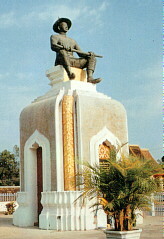
King Setthathirath
HISTORY REVIEW
Human beings began living in the present territory of Laos
more than 10,000 years ago. Stone tools implements and skulls discovered in
Huaphan and Luang Prabang provinces certify the existence of such settlements.
The giant jars in Xieng Khouang province and stone columns in Huaphan province
date from the Neolithic period. As clearly as the last century B.C. humans in
Laos used iron to forge their tools.
The rural community grouping of people slowly formed into muang (townships)
between fourth and eight century on both sides of the Mekong River and along its
tributaries.
In 1349-1357, a movement emerged under the command of King Fa Ngoum, a national
hero, to group the muang into a unified Lan Xang Kingdom, the capital of which
stood at Xiengdong Xiengthong, now known as Luang Prabang.
From then on, the Kingdom of Lan xang entered into an era of national defense
and construction under King Fa Ngoum who first introduced Hinayana Buddhism from
the Khmer Kingdom into Laos, which is still the religion professed by the
majority of Lao people.
From 1479 to 1570, the Lao people were forced to defend the country against
foreign aggressors.
 King Setthathirath |
Under the rule of King Setthathirath, the capital was moved
from Xiengdong Xiengthong to Vientiane in 1560. A moated rampart was built to
protect the new capital whose name means the rampart if sandalwood. King
Setthathirath built a shrine to house the Phra Kaeo, the Emerald Buddha.
He also erected the That Luang Stupa, a venerated religious shrine which is now
the symbol of the Lao nation.
In the seventeenth century, under the reign of King Souliyavongsa, the Kingdom
entered its most brilliant era. It was respected by neighboring countries and
was reputed in many countries of the world. in 1694, a Dutch merchant of the
East Indian Company, Geritt Van Wuysthoff, and later, two Italian missionaries,
Leria and Marini, visited the Kingdom of Lan Xang. They wrote awed reports on
the rich and beautiful palaces and temples, and the splendid religious
ceremonies, saying Vientiane was the most magnificent city in South East Asia.
At the end of the reign of King Souliyavongsa, the feudal lords of Lan Xang
became contenders for the throne which led to the division of the country into
three Kingdoms in 1713: Luang Prabang, Vientiane, and Champassak. The division
created opportunities for new foreign aggressors. The Lao people fought
relentlessly to recover their national independence, and the most fierce but
unsuccessful struggle (1827-1828) in the Kingdom of Vientiane was led by King
Anouvong, now a National Hero. Vientiane was ransacked completely destroyed by
the Siames, with the exception of That Luang and vat Sisaket. The Emerald Buddha
was taken to Bangkok.
In 1893, Laos became a French colony. The Lao people of different ethnic groups
under the leadership of the Communist Party of Indochina, founded in 1930,
continued to struggle for the self determination and independence of Laos as
well as that of Vietnam and Cambodia. Lao independence was recognized by the
Geneva Agreement on Indochina in 1954.
Despite the agreement, neo-colonialist stepped into Laos to replace the old.
During this time, the ethnic Lao people suffered enormously. The pain of the
people and the destruction of land and property was beyond physical measure.
Because of the perseverance and struggle of the Lao people, victory after
victory was scored until the people was able to seize power throughout the
country, and the Lao People's Democratic Republic was established on December 2,
1975.